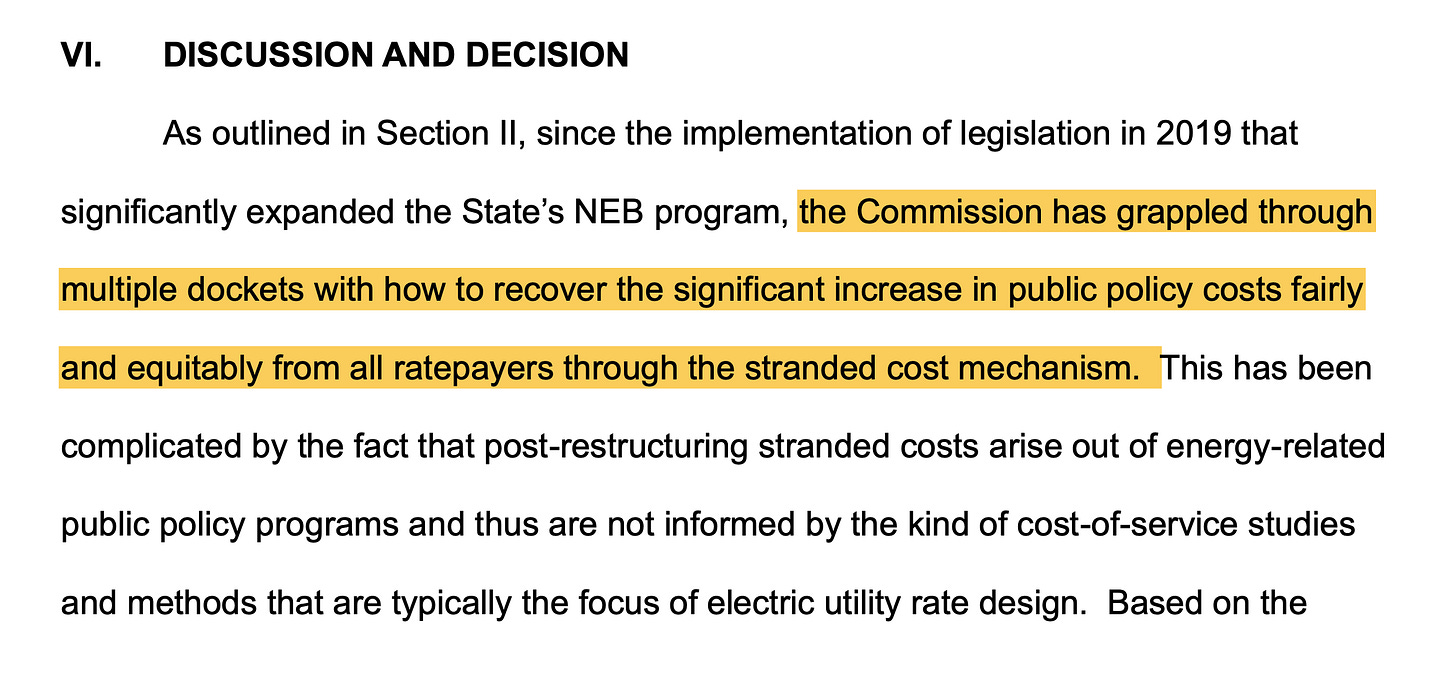Rejected!?
PUC rejects stipulation agreement and goes with volumetric. What does it mean?
I’ve been trying to understand the mystery of the Net Energy Billing (NEB) in Maine over the past few posts. This behemoth of a program is created through incentives and subsidies, and proves very, very hard to understand.
Subsidies mask market mechanisms and so parsing out the impacts is really hard for people outside of the industry.
The rejection of the stipulation agreement is item number 319 on the docket 2024-00137.
When we heard about the potato processing plant being charged $57k a month in fixed public policy charges - that’s a fixed cost. A volumetric charge would be based on how much they used.
In this context, the phrase stranded costs and NEB are often used interchangeably, though it’s not accurate. It’s used that way because a majority of the stranded costs charges are due to NEB at this point in time.
Stranded costs emerged as a legislative carrot when the utilities were forced out of the generation business in the late 1990s.
In NEB, there are two programs. The key things to remember are this:
kWh program is typically used with home solar installations, i.e. often rooftop and grid-tied. This program is responsible for about 25% of the massive NEB charges. A subscriber (i.e. homeowner) gets kWh credits that they use at night and in winter. These credits expire or go to low-income ratepayers within a year.
the Tariff Rate program is used for commercial, industrial, and community solar projects or larger. These project owners get actual MONEY from CMP/Versant, and are paid a rate that is HIGHER than the going wholesale rate. In the case of community solar, the project owner keeps their subscriber’s Delivery charges - even though they aren’t responsible for maintaining the T&D system. (i.e. trucks and human power)
The tariff rate program is responsible for 75% of the NEB overall costs, because it REQUIRES UTILITIES TO BUY RENEWABLE ENERGY AND (OFTEN) SELL IT AT A LOSS!
(Who comes up with this stuff?)
They have to buy it because of the legislation. And they have to sell it real-time, because that’s how electricity works. There aren’t batteries built into this system. The electrons just flow.
As far as I can determine, the PUC has swung back and forth over the past few years trying to determine a fair way to handle the behemoth.
In 2021: PUC ordered utilities to recover both kWh program and tariff rate program through stranded cost mechanism (and not through distribution rates.)
In 2022: The PUC changed course and determined that NEB portion of stranded costs should be recovered through fixed charges, while other stranded costs should be recovered volumetrically.
In 2023: the fixed charge for NEB costs was implemented into rates, and “generator rate classes” (i.e. large industrial customers) saw enormous electrical bill increases.
In 2024: PUC decided that because ALL stranded costs benefit ALL Mainers (you agree, right? 😂) ALL stranded costs should be recovered through fixed charges.
In 2025: The stipulation agreement was proposed by a group of larger customers and supported by the OPA. Preserve Rural Maine filed a letter in the docket pointing out that the stipulation agreement appeared to result in a rate adjustment to some classes without proper notice.
What did the stipulation agreement propose? It proposed increasing stranded costs charges to smaller commercial and residential customers by 18% (thus decreasing them on the heavily burdened large customers) and it mixed between fixed charges and volumetric charges. It also had a method for creating a Low Income Bill Credit.
The commission rejected this proposal as not being in the public interest (despite OPA support.)
I read the stipulation agreement last week, and thought that it would probably be approved. It’s a bandaid to put on top of the other bandaids that we already have. I was planning to post this week about how I expect the commercial bill I watch, as well as all other medium and small commercial services, to increase by 10% this summer. However, that post will go unposted!
It’s also necessary to point out: the burden of participating in a docket such as 00137 is impossible for most individuals. Nobody was specifically representing the interests of small and medium businesses amongst the intervenors.
Below, the PUC notes that this has been a multi year process to come back to a fully volumetric charge. (Spreading NEB costs completely pro-rata based on usage)
Question: does that apply to residential too? Because that will be interesting.
Now, how are we measuring the volume of a house that uses 8400 kWh per year (i.e. 700 kWh per month) but has solar panels which have offset what they need to pull from the grid? Are they volumetric NEB charged on their usage (8400 kWh per year)?
As always, let me know if I have gotten anything wrong. I have a background in business, I’m pretty good with numbers and language, but I’m trying to figure out this opaque behemoth and put it into easier to understand language. There might be mistakes.







This is the examiner's report in which they are recommending the commissioners order stranded costs be paid by kilowatt hour volumetric method by all classes and it be ordered that a proceeding be opened to discuss the implementation of a non-bypassable volumetric charge.
In other words the more electricity you use, the more you pay and people with NEB will be charged for NEB costs for all power their building consumes whether it was from solar generation or utility power.
They want comments on this recommendation by March 17th.